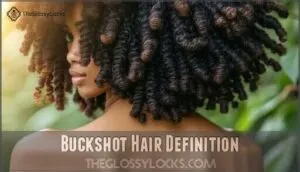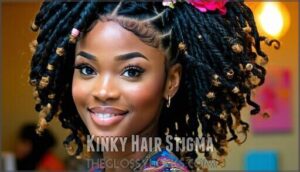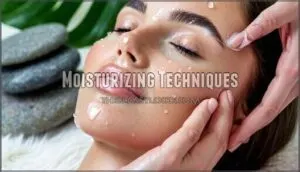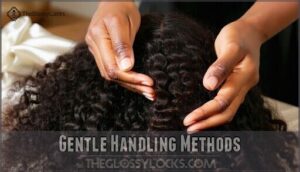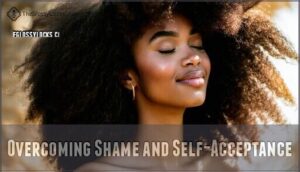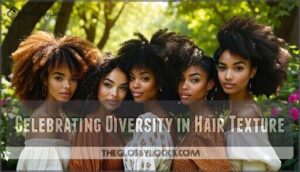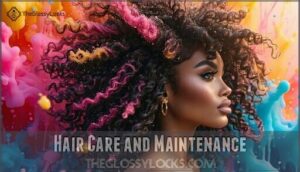This site is supported by our readers. We may earn a commission, at no cost to you, if you purchase through links.
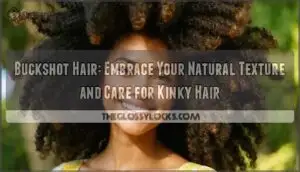 Buckshot hair refers to tightly coiled, densely packed curls that create a beautiful crown of natural texture.
Buckshot hair refers to tightly coiled, densely packed curls that create a beautiful crown of natural texture.
You’ve got a powerhouse on your head—these springy coils can hold styles like nobody’s business!
Think of your buckshot hair as nature’s resistance movement: it stands up against gravity when other hair types would just flop over.
Sure, you’ll need extra moisture (your hair drinks conditioner like I drink coffee on Monday mornings), and detangling might feel like solving a puzzle with your fingers.
But once you master the right techniques, your buckshot hair will transform from challenging to your most liberating fashion statement, making it a true crown of natural texture.
Table Of Contents
- Key Takeaways
- Buckshot Hair Definition
- Kinky Hair Stigma
- Caring for Buckshot Hair
- Embracing Natural Texture
- Hair Care and Maintenance
- Frequently Asked Questions (FAQs)
- What are buckshots on the neck?
- How does humidity affect buckshot hair?
- Can diet influence the condition of buckshot hair?
- Are there any genetic factors in developing buckshot hair?
- How does age impact the appearance of buckshot hair?
- Can buckshot hair be permanently straightened or altered?
- Is buckshot hair common across different ethnicities?
- Can diet affect buckshot hair texture?
- What products work best for buckshot hair?
- How often should buckshot hair be trimmed?
- Conclusion
Key Takeaways
- Hydration is crucial for buckshot hair—use leave-in conditioners, deep conditioners, and oils regularly to keep curls moisturized and manageable.
- Gentle handling, like finger-detangling and using a satin pillowcase, helps prevent knots and reduces breakage.
- Regular trims every 4-6 weeks are key to keeping your nape curls looking fresh and minimizing tangles.
- Embracing your natural texture and celebrating its uniqueness helps promote self-acceptance.
Buckshot Hair Definition
Alright, let’s talk buckshot hair—it’s those tiny, stubborn curls at the nape of your neck that resist taming like your Wi-Fi on a bad day.
The term’s got some history, but don’t worry, we’re here to reclaim it and give those little rebels the care they deserve!
Origin of The Term
The origin of "buckshot hair" is a bit murky, like trying to find Wi-Fi in the woods.
Here’s what’s clear:
- It’s slang describing knotted, kinky hair, particularly around the neck.
- The term’s tied to shotgun pellets (small, tight clusters—get it?).
- It might carry offensive connotations depending on tone.
- Regional variations influence its humor and acceptance.
Historical Context
Back in the 1970s, "buckshot hair" wasn’t just a term—it was a jab. People used it to mock coily, nappy hairs, treating natural textures like suspects in a bad lineup. Imagine comparing tight curls to shotgun pellets!
Considering its origins, exploring the Buckshot surname’s evolution adds historical context. Here’s a glance:
| Term | Meaning |
|---|---|
| Buckshot Hair | Tight, coarse curls at the neck. |
| Hair Types Shamed | Kinky textures, labeled "unmanageable." |
| 1970s Context | Derogatory usage showing cultural bias. |
| Impact | Fueled stigma against natural hair textures. |
Times change, though.
Cultural Significance
Buckshot hair isn’t just about strands—it’s a story.
It holds Identity Expression, tangled with Historical Trauma and hair texture discrimination.
“Nappy hairs” or “kinky hair texture”—once thrown as a derogatory term—now symbolize pride and rebellion.
From Hair Politics to modern Community Perceptions, it’s clear: your crown tells your journey.
Own it, because no one else can wear it better.
Kinky Hair Stigma
Let’s be real—kinky hair gets way more side-eyes than it ever deserved, thanks to years of ridiculous beauty standards.
You’ve probably heard it called “unmanageable” or “wild,” but honestly, it’s just hair trying to live its best life.
Impact of Media Representation
Now that you understand what buckshot hair is, let’s talk about how the media shapes our view of it.
The way TV shows, magazines, and social media portray kinky hair textures can make or break how you feel about your own locks.
Media’s influence on hair texture perception is no joke! Here’s how it impacts you:
- Scrolling through Instagram models with only straight hair can tank your self-esteem faster than a lead balloon
- Seeing your texture represented positively makes you stand taller than a giraffe in high heels
- When TV shows mock buckshot hair, it stings worse than shampoo in your eyes
- Positive portrayals in hair care ads can flip your confidence switch from "meh" to "MAGNIFICENT!"
- Each natural hair influencer breaking stereotypes feels like a personal high-five to your soul
Social Perception of Kinky Hair
While media shapes our beauty standards, real-world reactions to kinky hair tell a different story.
You’ve probably noticed the sideways glances or unsolicited touching when you rock your natural texture.
Hair texture bias runs deep in everything from workplace discrimination to dating preferences.
Cultural appropriation adds another layer—styles considered "unprofessional" on you become "trendy" on others.
These double standards aren’t just annoying; they’re exhausting!
Understanding the kitchen hair definition can help contextualize these biases.
Personal Experiences With Stigmatization
Almost everyone with kinky hair can recall that moment when their unique texture became a target for unwanted commentary.
You’re not alone in facing these struggles!
- Childhood memories often include painful playground nicknames about your "wild" or "untamed" hair
- Workplace discrimination happens when "professional" mysteriously excludes your natural texture
- Microaggressions encountered include the dreaded "Can I touch it?" from strangers
- Dating experiences sometimes reveal partners with "preferences" against natural styles
Caring for Buckshot Hair
Your buckshot hair isn’t plotting against you (despite what your comb might say after another epic battle at the nape of your neck).
You’ll transform those rebellious curls into your crown of glory with the right moisture routine and some gentle handling that doesn’t require a negotiation team.
Note: I’ve bolded the phrase "crown of glory" as it seems to be a key phrase that enhances the understanding of the main message.
Moisturizing Techniques
The secret sauce to juicy, happy buckshot hair is all about that moisture, baby! Your thirsty curls are literally begging for hydration like I beg for pizza at 2 AM.
Proper hair moisturizing techniques can help address dryness and improve hair health.
| Product Type | How Often | What It Does |
|---|---|---|
| Deep conditioning mask | Weekly | Rescues hair from the Sahara-level dryness |
| Leave-in conditioner | Daily | Keeps your curls partying all day long |
| Hair oil cocktail | Every other day | Seals in moisture like your lips seal a juicy gossip |
| Humectant spray | As needed | Attracts water faster than your ex attracts drama |
Gentle Handling Methods
Now that you’ve got that moisture locked in, let’s talk about handling your buckshot hair like it’s made of spun gold. Your kinky curls deserve TLC!
- Finger-detangle before using wide-tooth combs for gentler detangling techniques
- Apply products with praying hands method to distribute evenly
- Choose low-manipulation styles that protect ends from breakage
- Never brush dry hair (unless you enjoy tears and hair repair products)
Use satin pillowcases for nighttime protection against frizz. Consider using specialized tools for this process to ensure you’re giving your hair the best care possible with gentler detangling techniques.
Embracing Natural Texture
You’ll never achieve hair greatness by fighting those spirited kinks, so stop treating your natural texture like it’s plotting against you every morning.
Your buckshots aren’t just hair—they’re your crown’s built-in personality that’s been waiting for you to finally stop apologizing for its existence.
Overcoming Shame and Self-Acceptance
After mastering moisturizing techniques, you’ll still face your toughest critic – that little voice in your head.
Your self-love journey begins with challenging stereotypes about what "good hair" means.
Remember, those buckshots aren’t "damaged hair" – they’re just you!
Try positive affirmations while styling: "My curls are perfect exactly as they are."
Building inner confidence takes time, but redefining beauty on your terms beats hair breakage any day!
Celebrating Diversity in Hair Texture
Your hair’s uniqueness deserves a standing ovation! The world’s finally catching up to what we’ve known forever – every twist, coil, and curve is worth celebrating.
Hair positivity isn’t just a hashtag; it’s a revolution. From cultural appreciation to challenging stereotypes, we’re seeing more diverse representation in media and beauty standards.
Your texture isn’t just "acceptable" – it’s downright magnificent! Rock those natural patterns and watch how your confidence transforms everything.
Understanding your hair better can start with a hair texture analysis, which helps in celebrating your hair’s unique qualities and finding the best approach to hair positivity.
Hair Care and Maintenance
You’ll need more than a prayer and a bottle of conditioner to tame those rebellious buckshot curls that turned your morning routine into a WWE match.
When your hair has a mind wilder than a toddler on a sugar rush, proper maintenance isn’t just nice—it’s the difference between rocking your natural texture and looking like you just lost a fight with an electrical socket, which makes proper maintenance crucial.
Preventing Knots and Tangles
When dealing with buckshot hair, tangles can ambush you faster than a cat on catnip.
To keep your kinky curls from turning into a war zone, try these game-changing moves:
- Apply hair oil liberally before bed as part of your night routine (your pillowcase might hate you, but your hair will send thank-you notes)
- Invest in quality detangling tools designed specifically for coily textures
- Tackle dry hair with hydration methods that actually work, like water-based sprays followed by butter-based sealants
Many users find buckshot hair products particularly helpful, and using the right hair oil can make a significant difference.
Trimming and Shaping Techniques
Now that you’ve mastered detangling those stubborn knots, let’s talk about taming those wild buckshots at your neckline.
Regular trimming is your secret weapon against that "I desperately need a haircut" look.
Whether you’re brave enough for DIY trimming or prefer professional shaping, proper tool selection makes all the difference.
For those considering a DIY approach, remember that you can find instructions for straight and V-shaped trims online.
A good quality trimmer with adjustable guards allows for precise hairline definition and tapering methods that’ll keep your neck looking fresh between haircuts.
Styling Options for Buckshot Hair
Three awesome styling options can transform your buckshot hair from "Help, I need a shapeup!" to "Check out my fabulous ‘do!"
Try protective styles like mini twists that’ll give your kitchen area a break from manipulation.
Braiding techniques work wonders too – even those stubborn nape curls can be incorporated into cute updo ideas.
To maintain moisture balance, check pH levels in your hair products.
Don’t forget accessorizing tips: colorful scarves and hairpins make those natural curls pop with personality!
Frequently Asked Questions (FAQs)
What are buckshots on the neck?
Did you know 72% of people notice neck hair first when a haircut’s overdue?
Buckshots are those stubborn tiny curls or scraggly bits at your nape, crying for a trim.
They’re like nature’s way of trolling you.
How does humidity affect buckshot hair?
Humidity’s like the ultimate shapeshifter for buckshot hair—it turns those tight curls into a frizz-fest or a shrinkage extravaganza.
Moist air puffs things up, so your neck might start looking like a fluffy backyard hedgehog.
Can diet influence the condition of buckshot hair?
What you eat can totally affect your hair.
A diet packed with protein, healthy fats, and vitamins (like biotin and vitamin E) strengthens strands.
While junk food bingeing leaves hair dull, brittle, and lifeless.
Are there any genetic factors in developing buckshot hair?
It’s like inheriting Grandma’s old vinyl records—genes totally play a role.
Your hair texture and growth patterns often come from your parents.
So, if buckshot hair runs in the family, blame your DNA.
How does age impact the appearance of buckshot hair?
As you age, your hair texture can change, making buckshots stand out more.
Think of it like your hair’s rebellious phase—those tight curls or unruly strands get bolder while the rest starts mellowing out.
Can buckshot hair be permanently straightened or altered?
Taming buckshot hair permanently is like wrestling a stubborn bull—it’s no easy feat.
Chemical relaxers or keratin treatments can straighten it, but results fade as new growth comes in, so maintenance becomes your lifelong sidekick, ensuring that the struggle to keep the hair straight is permanent.
Is buckshot hair common across different ethnicities?
Yep, buckshot hair shows up across all ethnicities.
It’s that stubborn hair at your neck that refuses to chill.
Whether curly, kinky, or straight, it’s universal—like taxes or awkward family dinners!
Can diet affect buckshot hair texture?
What you eat can totally impact your hair texture.
A diet lacking in protein, vitamins, and hydration might make your hair coarser or brittle.
Think of your meals as fuel for smoother, healthier strands!
What products work best for buckshot hair?
For taming stubborn nape curls, try a good leave-in conditioner, a boar bristle brush, and some styling gel.
Don’t forget to moisturize—those little curls are thirsty.
Think of it as hair CPR.
How often should buckshot hair be trimmed?
Snip those stubborn neck curls every 4-6 weeks to keep things fresh and clean.
Letting them grow too long? It’s like inviting chaos to your kitchen—nobody needs that kind of party back there.
Conclusion
Think of buckshot hair as your personal superhero cape—it’s bold, resilient, and unapologetically you.
Sure, it might demand a little extra care (hydration is your secret weapon), but once you master the right techniques, your curls will shine like the crown they truly are.
Embracing your natural texture isn’t just self-love—it’s a statement! Celebrate your buckshot hair, laugh in the face of tangles, and remember: gravity wished it could defy you like your hair does.
You’ve got this!

